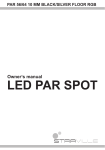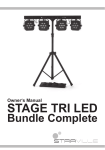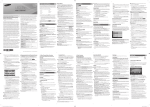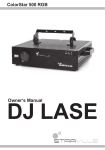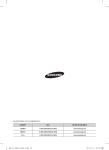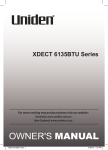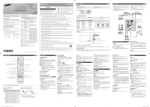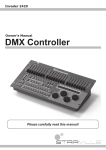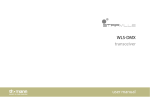Download Owner`s Manual • VHF WIRELESS INEAR SYSTEM • IEM 100
Transcript
IEM 100 - 800 / 100 - 863 MHZ Owner’s Manual VHF WIRELESS INEAR SYSTEM Thanks a lot for purchasing our wireless InEar system. Please read this user manual carefully and follow the instructions to avoid danger or damage to the unit due to mishandling. Keep this user guide for future reference. If you give the unit to another user, be sure that he also receives this instruction booklet. Safety instruction You have to carefully read the instruction, which includes important information about the installation, usage and maintenance, BEFORE operating this device. XXUnpack and check carefully there is no transportation damage before using the unit. XXBefore operating, ensure that the voltage and frequency of the power supply match the power requirements of the unit as stated in this manual. XXNever sever the power cord’s earth wire of any device. Otherwise a LIFE THREATENING situation exists! XXThe unit is for indoor use only. Use it only in a dry location. Exposing the device to rain or moisture would cause the risk of electrical shock or fire. XXThe unit must be operated in a location with adequate ventilation. Be sure that no ventilation slots are blocked during operation. XXDisconnect the device from the mains power before any servicing or maintenance. XXDO NOT let any liquids or objects enter the unit. Should any liquid be spilled on the unit, DISCONNECT the power supply to the unit immediately and contact the service company. XXKeep any flammable material away from the unit while it is operating. Otherwise you run the risk of causing a fire. XXIn the event of serious operating problems, stop using the unit immediately. Never try to dismantle, repair or modify the unit by yourself. Otherwise warranty becomes void. Repairs carried out by unskilled people can lead to damage or malfunction. Please contact the nearest authorized technical assistance centre. Always use the same type spare parts. XXUnder no circumstances may you open the device housing. Should you do so your safety would not be assured and the warranty will become void. There are no operational components whatsoever inside! 2 T.BONE • IEM 100 - 800 / 100 - 863 MHZ XXNEVER use the unit under the following conditions: > In places subject to vibrations or bumps. > In places with a temperature of over 50°C or less than -10°C. > In places subject to excessive dryness or humidity (ideal conditions are between 35% and 80%). XXNever leave the device unattended during operation. XXBefore a storm and/or a thunderstorm with a risk of lightning, please disconnect the device from the electrical power source. XXThis unit must only be operated by adults. Never allow children to tamper or play with it. Packaging material (plastic bags, polystyrene foam, nails, etc.) MUST NOT be left within children’s reach, as it can be dangerous. XXKeep batteries well away from children. Children can put batteries into their mouths and swallow them. If a battery is swallowed medical assistance must be sought IMMEDIATELY. XXNotice regarding disconnection from mains-power: To completely disconnect the device from mains power, you must disconnect the adaptor from the power socket. For this reason the device should be placed in a position where unobstructed access to the power socket is assured at all times, so that in an emergency you will be able to immediately pull out the adaptor. To eliminate the risk of fire you should completely disconnect the adaptor from the power socket when the device is not going to be used for a long time, for example, during holidays. XXAlways grasp the power adaptor itself. Do not pull on the cord and never touch the power adaptor with wet hands as this could result in a short circuit or an electrical shock. Do not place the device, speakers or anything else on the adaptor cord and make sure that it does not become clamped. Never tie knots in the adaptor cord and do not bind it together with other cables. Lay the adaptor cord so that no one can step on or stumble over it. A damaged power adaptor can cause a fire or an electrical shock. Check the power adaptor and its cord from time to time. Should it become damaged contact our customer service department to have it replaced. XXThis appliance must not be used by individuals (including children) with restricted physical, physiological or intellectual abilities or deficiencies in experience and/or knowledge unless they are supervised by a person responsible for their safety or receive from this person instruction in how the appliance is to be used. Keep children away from the device and power cord! www.thomann.de 3 Overview Transmitter front view 1.POWER 2.INPUT LEVEL 3.LCD 4.SET 5. 6. 7.PHONES 8.VOLUME 4 Keep this button pressed for 2 seconds to switch the unit on or off. Turn this control to set the input sensitivity. The LCD displays information about operating or setup. Transmitter setup button. To navigate downwards within the menu. To navigate upwards within the menu. Connect headphones with a 1/4” jack here. Volume control for the headphones output. Turn it clockwise to increase the volume. Turn it counterclockwise to the decrease volume. T.BONE • IEM 100 - 800 / 100 - 863 MHZ Transmitter rear view 1.DC INPUT 2.LEFT INPUT 3.RIGHT INPUT 4.PAD 5.ANTENNA Only connect the cable of the mains adaptor provided to this socket. Connect the audio signal to be transmitted via left channel to this combo XLR jack. Connect the audio signal to be transmitted via right channel to this combo XLR jack. Set this switch to „-12 dB“, to attenuate the input signals by 12 dB. If you set it to „0 dB“ there will be no attenuation. Connect the transmitter antenna provided here. www.thomann.de 5 Receiver view 1.ANT 2.RF 3.PHONES 4.ON / OFF 5.LCD 6. 7. 8.ESC 9.SET 6 MAX Connect the receiver antenna provided here. This LED lights up, when the unit receives a transmission signal. Connect the earphones here. On-/Off switch and volume control: Turn this knob clockwise past the resistance to switch the receiver on. Turn it further to increase the volume. Turn this knob counterclockwise to decrease the volume. Turn it further past the resistance to switch the receiver off. The LCD displays information about operating or setup. To navigate downwards within the menu. To navigate upwards within the menu. To decline or quit within the menu. Programming button. T.BONE • IEM 100 - 800 / 100 - 863 MHZ Operating the device Wearing the backpack transmitter Clip the transmitter to your belt q, or slide a guitar strap through the transmitter clip w as shown. For best results, slide the transmitter until the belt is pressed against the base of the clip. Changing the batteries Depending on volume and battery brand the expected life time for two alkaline batteries is about 5 hours. If there’s only one bar left in the battery indicator, the batteries must be changed immediately to keep up proper function. Therefore open the battery compartment (A), take out the spent batteries and replace them by a pair of fresh ones with same brand and specs, obeying the correct polarity. If you disregard the polarity the unit won’t work and may be damaged. Then close the battery compartment. Check the condition of the batteries regularly. Acid leaking from a battery may damage the unit. If you will not use the device for a longer period of time, remove the batteries to prevent them from discharging and leaking. Should the batteries leak, put on a pair of protective gloves and clean the battery compartment and terminals with a dry cloth. www.thomann.de 7 Transmitter setup Frequency group and channel selection: Press the SET button, until the GROUP indicator flashes. Choose a suitable group using the / buttons, as shown in the diagrams on the left. Then press the SET button again, until the CHANNEL indicator flashes. Now use the / buttons, to select a suitable channel. Note: When using multiple systems, for optimum results set all systems to the same group and select a different channel number for each system on that group. Working mode selection: Press the SET button repeatedly, until the STEREO or MONO indicator appears. Use the / buttons to toggle the operation mode. Press the SET button again to save the selected operating mode. The lock function: Press the SET button repeatedly, until the symbol appears. Now press the or button, to release or lock the unit. A locked unit allows you to view the settings, but not to change them. Audio input level indication: The display indicates the input level as shown on the left, but only in STEREO mode. Use the / buttons, to set the input level as desired. 8 T.BONE • IEM 100 - 800 / 100 - 863 MHZ Receiver setup Frequency group and channel selection: Press the SET button, until the GROUP indicator flashes. Now use the / buttons, to choose the same group as previously set up in that transmitter, which has to supply this receiver. Refer to the illustrations shown on the left. Then press the SET button again, until the CHANNEL indicator flashes. Now use the / buttons, to select the same channel as previously set up in that transmitter, which has to supply this receiver. HF setting: Press the SET button repeatedly, until the HF indicator (high frequency) flashes. If you activate this function using the / buttons, the frequencies around 10 kHz will be raised by 6 dB. When deactivated, the frequency response remains unchanged. The lock function: Press the SET button repeatedly, until the symbol appears. Now press the or button to release or lock the unit. A locked unit allows you to view the settings, but not to change them. www.thomann.de 9 RF signal indicator: The receiver indicates the strength of the RF signal with 5 bars of different height. Battery power indicator: The more bars shown in the battery symbol, the more powerful are the inserted batteries. And this is how the LCD looks in normal operation. Disposal Never throw the device into the regular household waste at the end of its useful life. This product is subject to the European Directive 2002/96/EC. XXDispose of the device through an approved disposal centre or at your community waste facility. XXObserve the current existing regulations. In case of doubt contact your disposal facility. XXThe packaging is certified via a dual system. Take all packaging materials to an environmentally friendly disposal facility in compliance with the local regulations. 10 T.BONE • IEM 100 - 800 / 100 - 863 MHZ Technical specifications Total system Transmission frequency range Transmitter output level Operating range Audio frequency response THD Dynamic range Operating temperature range Model 100-800: 790 – 814 MHz Model 100-863: 863 – 865 MHz 10 dBm 50 m Ø (under typical conditions) 60 Hz – 16 kHz ± 3 dB < 1 % @ 1 kHz > 90 dB (A-weighted) -10 °C – + 50 °C (battery characteristics may limit this range) Transmitter Max. audio input level Gain adjustment range Input impedance Dimensions (H x W x D) Weight Power requirements Wiring XLR inputs + 12 dBV 40 dB 100 kΩ 44 x 212 x 160 mm 960 g 12 – 18 V , 300 mA, (delivered by mains adaptor supplied) Primary voltage of mains adaptor: AC 230 V Impedance balanced, Pin 1 = ground, Pin 2 = positive polarity terminal (hot), Pin 3 = negative polarity terminal (cold) Receiver Audio output level Sensitivity Image rejection Dimensions (H x W x D) Weight Power requirements Battery life 100 mW -94 dBm for 30 dB SINAD, typical > 55 dB 90 x 64 x 23 mm 100 g (without batteries) 2 x 1.5 batteries, size AA Ø 5 hours Our products are subject to a process of continual further development. Therefore modifications to the technical features remain subject to change without further notice. www.thomann.de 11 © 2011 • Musikhaus Thomann e. K. • Treppendorf 30 • 96138 Burgebrach • Germany • www.thomann.de

















